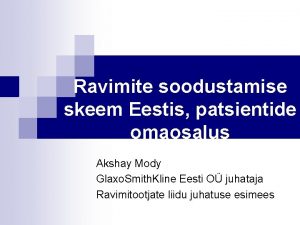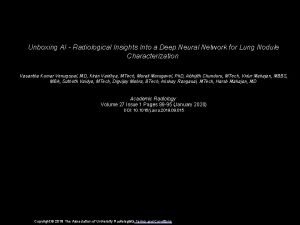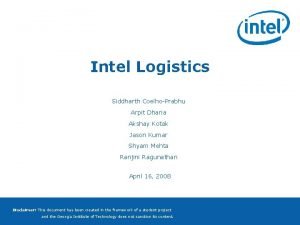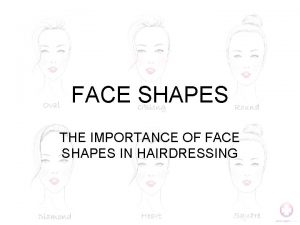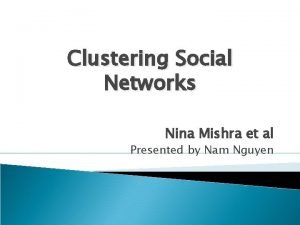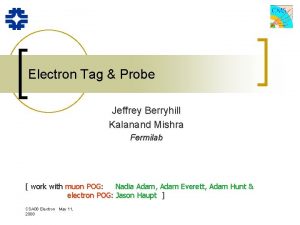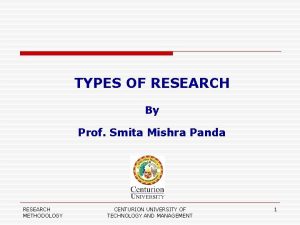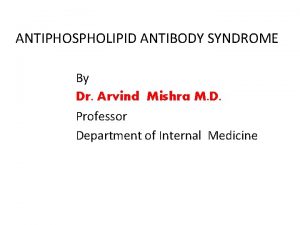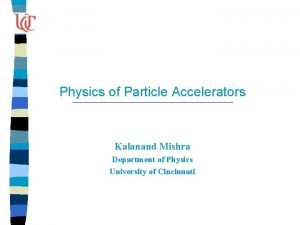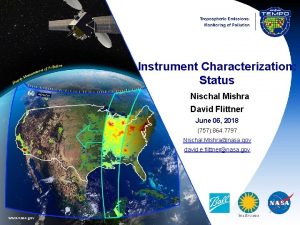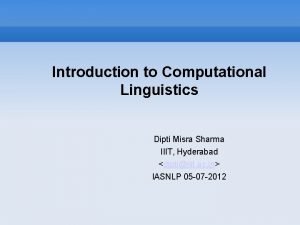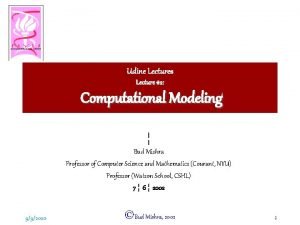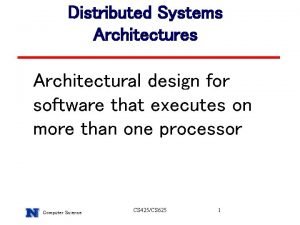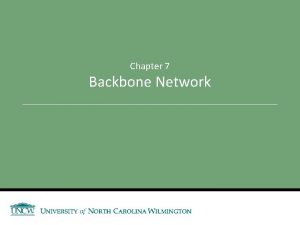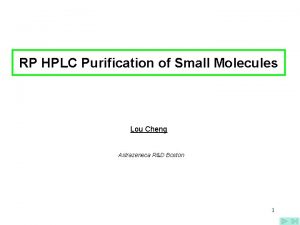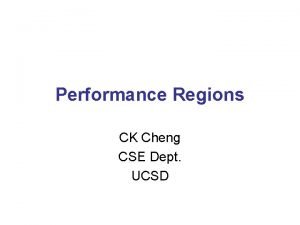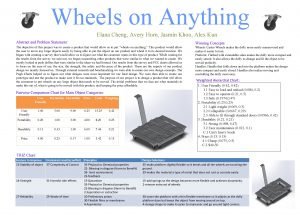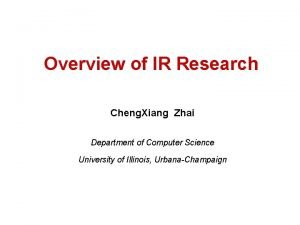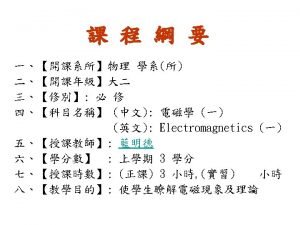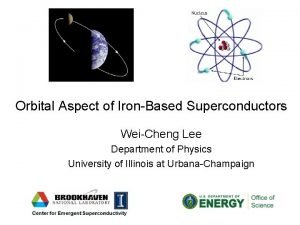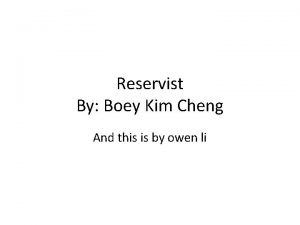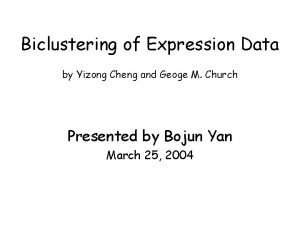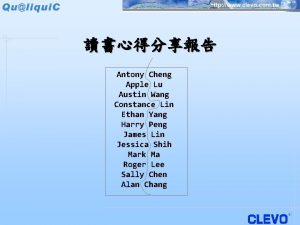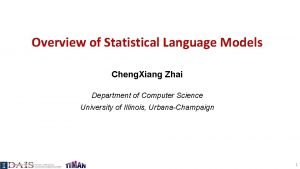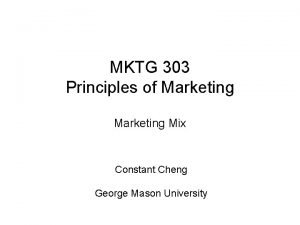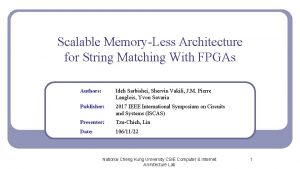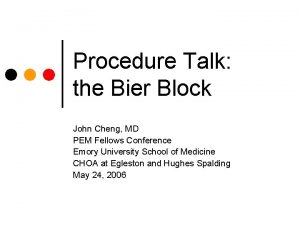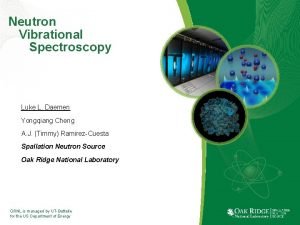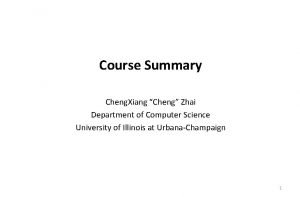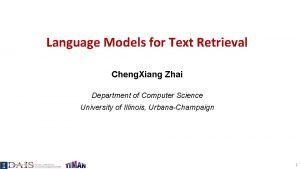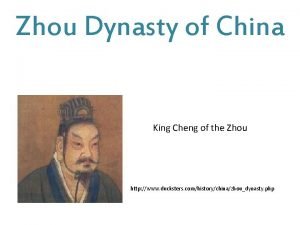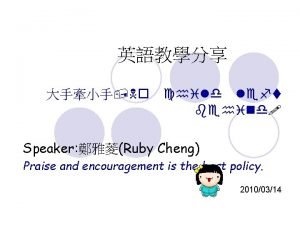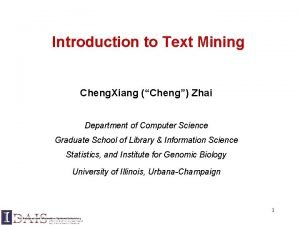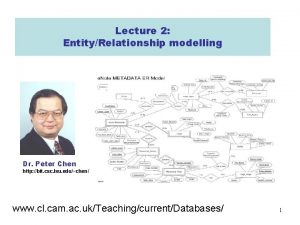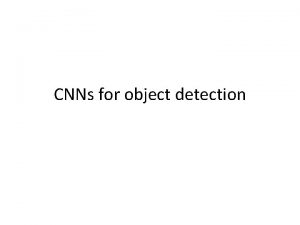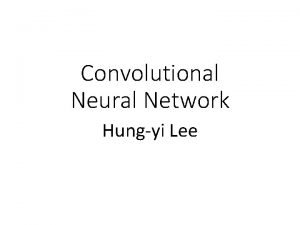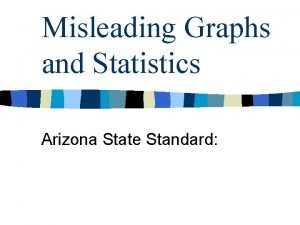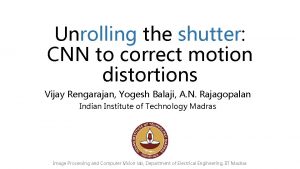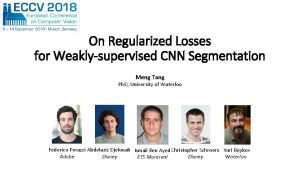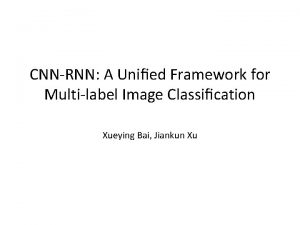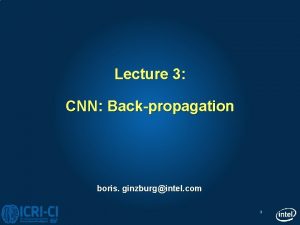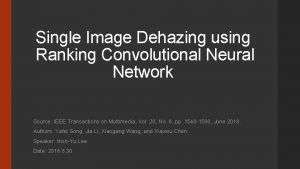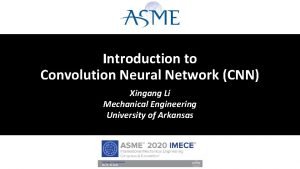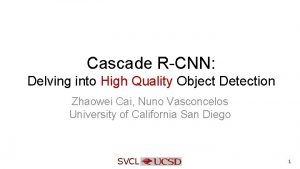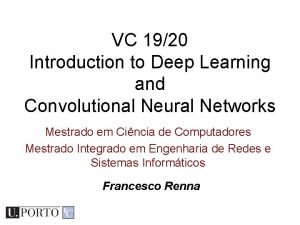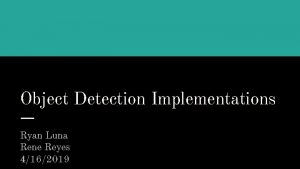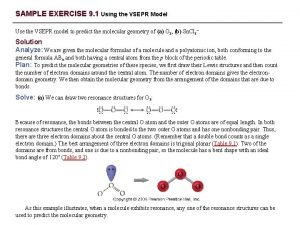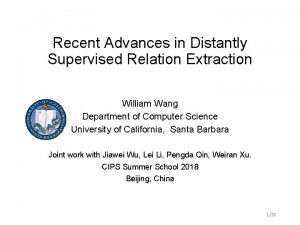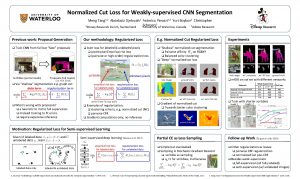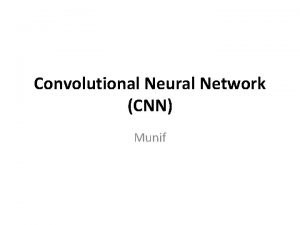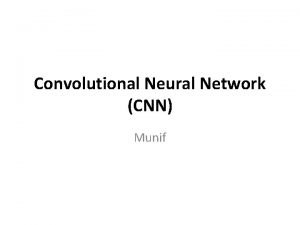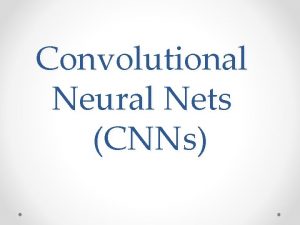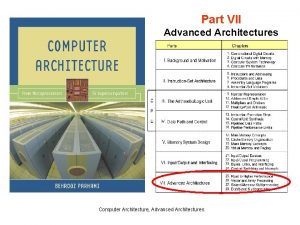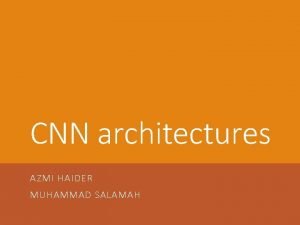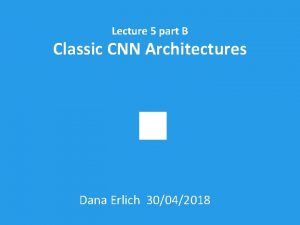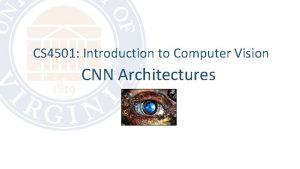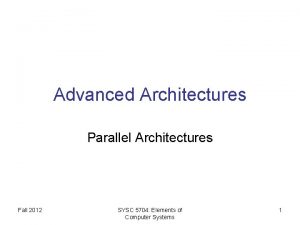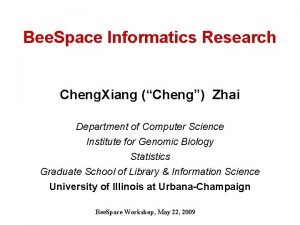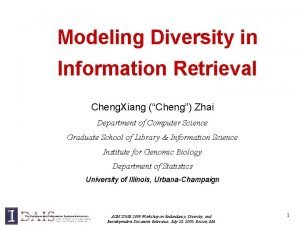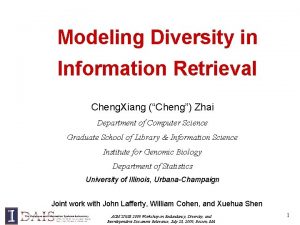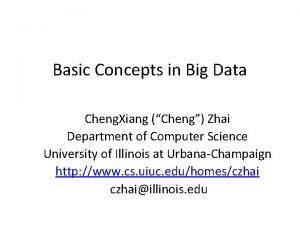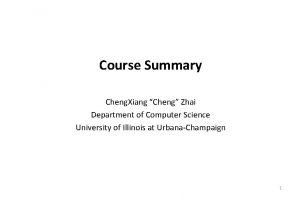Advanced CNN Architectures Akshay Mishra Hong Cheng CNNs



































![Rescaling Demo: I tried rescales of [1. 1, 1. 5, 3, 5, 10] Elephant Rescaling Demo: I tried rescales of [1. 1, 1. 5, 3, 5, 10] Elephant](https://slidetodoc.com/presentation_image_h2/37ebc37601cc62e6bfc08d90202fa893/image-36.jpg)



































































- Slides: 103

Advanced CNN Architectures Akshay Mishra, Hong Cheng

CNNs are everywhere. . . Recommendation Systems Drug Discovery Physics simulations Heng-Tze Cheng, Levent Koc, Jeremiah Harmsen, Tal Shaked, Tushar Chandra, Hrishi Aradhye, Glen Anderson, Greg Corrado, Wei Chai, Mustafa Ispir, Rohan Anil, Zakaria Haque, Lichan Hong, Vihan Jain, Xiaobing Liu, Hemal Shah, Wide & Deep Learning for Recommender Systems, arxiv 2016

CNNs are everywhere. . . Recommendation Systems Drug Discovery Physics simulations Izhar Wallach, Michael Dzamba, Abraham Heifets, Atom. Net: A Deep Convolutional Neural Network for Bioactivity Prediction in Structure-based Drug Discovery, arxiv 2016

CNNs are everywhere. . . Recommendation Systems Drug Discovery Physics simulations Jonathan Tompson, Kristofer Schlachter, Pablo Sprechmann, Ken Perlin, Accelerating Eulerian Fluid Simulation With Convolutional Networks, arxiv 2016

We’re focusing on Image. Net Gives us a common task to compare architectures Networks trained on Image. Net are often starting points for other vision tasks Architectures that perform well on Image. Net have been successful in other domains Alfredo Canziani & Eugenio Culurciello, An Analysis of Deep Neural Network Models for Practical Applications, ar. Xiv 2016

We’re focusing on Image. Net Gives us a common task to compare architectures Networks trained on Image. Net are often starting points for other vision tasks Architectures that perform well on Image. Net have been successful in other domains Example applications: ● Object detection ● Action recognition ● Human pose estimation ● Semantic segmentation ● Image captioning

We’re focusing on Image. Net Gives us a common task to compare architectures Networks trained on Image. Net are often starting points for other vision tasks Architectures that perform well on Image. Net have been successful in other domains Novel Res. Net Applications: ● Volumetric Brain Segmentation (Vox. Res. Net) ● City-Wide Crowd Flow Prediction: (ST-Res. Net) ● Generating Realistic Voices (Wave. Net)

Overview We’ve organized our presentation into three stages: 1. A more detailed coverage of the building blocks of CNNs 2. Attempts to explain how and why Residual Networks work 3. Survey extensions to Res. Nets and other notable architectures Topics covered: ● Alternative activation functions ● Relationship between fully connected layers and convolutional layers ● Ways to convert fully connected layers to convolutional layers ● Global Average Pooling

Overview We’ve organized our presentation into three stages: 1. A more detailed coverage of the building blocks of CNNs 2. Attempts to explain how and why Residual Networks work 3. Survey extensions to Res. Nets and other notable architectures Topics covered: ● Res. Nets as implicit ensembles ● Res. Nets as learning iterative refinements ● Connections to recurrent networks and the brain

Overview We’ve organized our presentation into three stages: 1. A more detailed coverage of the building blocks of CNNs 2. Attempts to explain how and why Residual Networks work 3. Survey extensions to Res. Nets and other notable architectures Motivation: ● Many architectures using residuals ○ Wave. Nets ○ Inception. Res. Net ○ Xception. Net ● Tweaks can further improve performance

Overview We’ve organized our presentation into three stages: 1. A more detailed coverage of the building blocks of CNNs 2. Attempts to explain how and why Residual Networks work 3. Survey extensions to Res. Nets and other notable architectures Motivation: ● Get a sense of what people have tried ● Show that residuals aren’t necessary for state-of-the art results ● By doing this towards the end, we can point out interesting connections to Res. Nets

Stage 1: Revisiting the Basics ● Alternative activation functions ● Relationship between fully connected layers and convolutional layers ● Ways to convert fully connected layers to convolutional layers ● Global Average Pooling

Review: Fully Connected Layers Takes N inputs, and outputs M units Each output is a linear combination of inputs Usually implemented as multiplication by an (N x M) matrix An example of fully connected layer.

Review: Fully Connected Layers Takes N inputs, and outputs M units Each output is a linear combination of inputs Usually implemented as multiplication by an (N x M) matrix An example of fully connected layer.

Review: Fully Connected Layers Takes N inputs, and outputs M units Each output is a linear combination of inputs Usually implemented as multiplication by an (N x M) matrix An example of fully connected layer.

How fully connected layers fix input size Convolutions can be thought of as sliding fully connected layers When the inputs to a convolutional layer are larger feature maps, outputs are larger feature maps Fully connected layers have a fixed number of inputs/outputs, forcing the entire network’s input shape to be fixed Think of this as fully connected layer that takes n x n inputs sliding across the input Image source: http: //deeplearning. net/software/theano_versio ns/dev/tutorial/conv_arithmetic. html

How fully connected layers fix input size Convolutions can be thought of as sliding fully connected layers When the inputs to a convolutional layer are larger feature maps, outputs are larger feature maps Fully connected layers have a fixed number of inputs/outputs, forcing the entire network’s input shape to be fixed The number of output feature maps corresponds to the number of outputs of this fully connected layer Image source: http: //cs 231 n. github. io/convolutional-networks/

How fully connected layers fix input size Convolutions can be thought of as sliding fully connected layers When the inputs to a convolutional layer are larger feature maps, outputs are larger feature maps Fully connected layers have a fixed number of inputs/outputs, forcing the entire network’s input shape to be fixed 256 x 256 128 x 128 32 x 32 16 x 16 4 x 4 What are the spatial resolutions of feature maps if we input a 512 x 512 images? Image source: http: //www. ais. unibonn. de/deep_learning/

How fully connected layers fix input size Convolutions can be thought of as sliding fully connected layers When the inputs to a convolutional layer are larger feature maps, outputs are larger feature maps Fully connected layers have a fixed number of inputs/outputs, forcing the entire network’s input shape to be fixed 256 x 256 128 x 128 32 x 32 16 x 16 4 x 4 What are the spatial resolutions of feature maps if we input a 512 x 512 images? Image source: http: //www. ais. unibonn. de/deep_learning/

How fully connected layers fix input size Convolutions can be thought of as sliding fully connected layers When the inputs to a convolutional layer are larger feature maps, outputs are larger feature maps Fully connected layers have a fixed number of inputs/outputs, forcing the entire network’s input shape to be fixed 512 x 512 256 x 256 64 x 64 32 x 32 8 x 8 The spatial resolutions are doubled in both dimensions for all feature maps. Image source: http: //www. ais. unibonn. de/deep_learning/

How fully connected layers fix input size Convolutions can be thought of as sliding fully connected layers When the inputs to a convolutional layer are larger feature maps, outputs are larger feature maps Fully connected layers have a fixed number of inputs/outputs, forcing the entire network’s input shape to be fixed 512 x 512 256 x 256 64 x 64 32 x 32 8 x 8 What happens to to the fully connected layers when input dimensions are doubled? Image source: http: //www. ais. unibonn. de/deep_learning/

How fully connected layers fix input size Convolutions can be thought of as sliding fully connected layers When the inputs to a convolutional layer are larger feature maps, outputs are larger feature maps Fully connected layers have a fixed number of inputs/outputs, forcing the entire network’s input shape to be fixed 512 x 512 256 x 256 64 x 64 32 x 32 8 x 8 It becomes unclear how the larger feature maps should feed into the fully connected layers. Image source: http: //www. ais. unibonn. de/deep_learning/

Fully Connected Layers => Convolutions Based on the relationships between fully connected layers and convolutions we just discussed, can you think of a way to convert fully connected layers to convolutions? By replacing fully connected layers with convolutions, we will be able to output heatmaps of class probabilities Jonathan Long, Evan Shelhamer, Trevor Darrell, Fully Convolutional Networks for Semantic Segmentation, ar. Xiv preprint 2016

Convolutionize VGG-Net’s final pooling layer outputs 7 x 7 feature maps VGG-Net’s first fully connected layer ouputs 4096 units What should the spatial size of the convolutional kernel be? How many output feature maps should we have? Image source: http: //www. robots. ox. ac. uk/~vgg/research/very_deep/

Convolutionize VGG-Net’s final pooling layer outputs 7 x 7 feature maps VGG-Net’s first fully connected layer ouputs 4096 units What should the spatial size of the convolutional kernel be? How many output feature maps should we have? Image source: http: //www. robots. ox. ac. uk/~vgg/research/very_deep/

Convolutionize VGG-Net’s final pooling layer outputs 7 x 7 feature maps VGG-Net’s first fully connected layer ouputs 4096 units What should the spatial size of the convolutional kernel be? ● Convolutional kernel should be 7 x 7 with no padding How many output feature maps should we have? Image source: http: //www. robots. ox. ac. uk/~vgg/research/very_deep/

Convolutionize VGG-Net’s final pooling layer outputs 7 x 7 feature maps VGG-Net’s first fully connected layer ouputs 4096 units What should the spatial size of the convolutional kernel be? ● Convolutional kernel should be 7 x 7 with no padding How many output feature maps should we have? Image source: http: //www. robots. ox. ac. uk/~vgg/research/very_deep/

Convolutionize VGG-Net’s final pooling layer outputs 7 x 7 feature maps VGG-Net’s first fully connected layer ouputs 4096 units What should the spatial size of the convolutional kernel be? How many output feature maps should we have? ● Convolutional kernel should be 7 x 7 with no padding to correspond to a non-sliding fully connected layer ● There should be 4096 output feature maps to correspond to each of the fully connected layers outputs Image source: http: //www. robots. ox. ac. uk/~vgg/research/very_deep/

Convolutionize VGG-Net What just happened? The final pooling layer still outputs 7 x 7 feature maps But the first fully connected layer has been replaced by a 7 x 7 convolution outputting 4096 feature maps The spatial resolution of these feature maps is 1 x 1 First and hardest step towards Jonathan Long, Evan Shelhamer, Trevor Darrell, Fully Convolutional Networks for Semantic Segmentation, ar. Xiv preprint 2016

Convolutionize VGG-Net How do we convolutionalize the second fully connected layer? The input to this layer is 1 x 1 with 4096 feature maps What is the spatial resolution of the convolution used? How many output feature maps should be used? Jonathan Long, Evan Shelhamer, Trevor Darrell, Fully Convolutional Networks for Semantic Segmentation, ar. Xiv preprint 2016

Convolutionize VGG-Net How do we convolutionalize the second fully connected layer? The input to this layer is 1 x 1 with 4096 feature maps What is the spatial resolution of the convolution used? How many output feature maps should be used? Same idea used for the final fully Jonathan Long, Evan Shelhamer, Trevor Darrell, Fully Convolutional Networks for Semantic Segmentation, ar. Xiv preprint 2016

Results Now, all the fully connected layers have been replaced with convolutions When larger inputs are fed into the network, network outputs grid of values The grid can be interpreted as class conditional heatmaps Jonathan Long, Evan Shelhamer, Trevor Darrell, Fully Convolutional Networks for Semantic Segmentation, ar. Xiv preprint 2016

Global Average Pooling Take the average of each feature map and feed the resulting vector directly into the softmax layer Advantages: 1) More native to the convolutional structure 2) No parameter to optimize. Overfitting is avoided at this layer. 3) More robust to spatial translations of input 4) Allows for flexibility in input size Min Lin, Qiang Chen, Shuicheng Yan Network In Network

Global Average Pooling In practice, the global average pooling outputs aren’t sent directly to softmax It’s more common to send the filter wise averages to a fully connected layer before softmax Used in some top performing architectures including Res. Nets and Inception. Nets Min Lin, Qiang Chen, Shuicheng Yan Network In Network

Rescaling Demo: I fed this picture of an elephant to Res. Net-50 at various scales Res. Net was trained on 224 x 224 images How much bigger can I make the image before the elephant is misclassified?
![Rescaling Demo I tried rescales of 1 1 1 5 3 5 10 Elephant Rescaling Demo: I tried rescales of [1. 1, 1. 5, 3, 5, 10] Elephant](https://slidetodoc.com/presentation_image_h2/37ebc37601cc62e6bfc08d90202fa893/image-36.jpg)
Rescaling Demo: I tried rescales of [1. 1, 1. 5, 3, 5, 10] Elephant was correctly classified up till 5 x scaling Input size was 1120 x 1120 Confidence of classification decays slowly At rescale factor of 10, ‘African Elephant’ is no longer in the top 3

Rescaling Demo: Raw predictions:

Review: Rectified Linear Units (Re. LU) Re. LU: max(0, x) What’s the gradient in negative region? Is there a problem?


Dying Re. LU Problem If input to Re. LU is negative for the dataset, Re. LU dies Brief burst of research into addressing dying Re. LUs General idea is to have non-zero gradients even for negative inputs Dead

Leaky Re. LU & Parameterized Re. LU In Leaky Re. LU, a is a hyperparameter. In Parameterized Re. LU, a is learned. Djork-Arné Clevert, Thomas Unterthiner, Sepp Hochreiter Fast and Accurate Deep Network Learning by Exponential Linear Units

Exponential Linear Units (ELUs) Djork-Arné Clevert, Thomas Unterthiner, Sepp Hochreiter Fast and Accurate Deep Network Learning by Exponential Linear Units

A tale of two papers. . . Top right: paper that introduced PRe. LUs Bottom right: paper that introduced Residual Networks What do you notice about these papers? Screenshots of both papers were taken from ar. Xiv

Contextualizing Same team that introduced PRe. LU created Res. Net Went back to Re. LUs for Res. Net Focus shifted from activations to overall network design Screenshots of both papers were taken from ar. Xiv

Contextualizing Same team that introduced PRe. LU created Res. Net Went back to Re. LUs for Res. Net Focus shifted from activations to overall network design

Contextualizing Same team that introduced PRe. LU created Res. Net Went back to Re. LUs for Res. Net Focus shifted from activations to overall network design

In conclusion The papers introducing each alternative activations claim they work well Re. LU still most popular All the architectures we are about to discuss used Re. LUs (and batch norm) Djork-Arné Clevert, Thomas Unterthiner, Sepp Hochreiter Fast and Accurate Deep Network Learning by Exponential Linear Units

Stage 2: “Understanding” Res. Nets

Review ● What is going on inside a Residual Block? (shown to the right) ● Why are there two weight layers? ● What advantage do they have over plain networks? Kaiming He, Xiangyu Zhang, Shaoqing Ren, and Jian Sun, Deep Residual Learning for Image Recognition, CVPR 2016

Going deeper without residuals Consider two non-residual networks We call the 18 layer variant ‘plain-18’ We call the 34 layer variant ‘plain-34’ The ‘plain-18’ network outperformed `plain-34` on the validation set Why do you think this was the case? Kaiming He, Xiangyu Zhang, Shaoqing Ren, and Jian Sun, Deep Residual Learning for Image Recognition, CVPR 2016

18 vs 34 layer ‘plain’ network Vanishing gradients weren’t the issue Overfitting wasn’t the issue Representation power wasn’t the issue Quote from Res. Net paper: We argue that this optimization difficulty is unlikely to be caused by vanishing gradients. These plain networks are trained with BN, which ensures forward propagated signals to have non-zero variances. We also verify that the backward propagated gradients exhibit healthy norms with BN. So neither forward nor backward signals vanish. Kaiming He, Xiangyu Zhang, Shaoqing Ren, and Jian Sun, Deep Residual Learning for Image Recognition, CVPR 2016

18 vs 34 layer ‘plain’ network Vanishing gradients weren’t the issue Overfitting wasn’t the issue Representation power wasn’t the issue Even the training error is higher with the 34 layer network Kaiming He, Xiangyu Zhang, Shaoqing Ren, and Jian Sun, Deep Residual Learning for Image Recognition, CVPR 2016

18 vs 34 layer ‘plain’ network Vanishing gradients weren’t the issue Overfitting wasn’t the issue Representation power wasn’t the issue ● The 34 network has more representative power than the 18 layer network ● We can choose padding and a specific convolutional filter to “embed” shallower networks ● With “SAME” padding, what 3 x 3 convolutional kernel can produce the identity? Kaiming He, Xiangyu Zhang, Shaoqing Ren, and Jian Sun, Deep Residual Learning for Image Recognition, CVPR 2016

18 vs 34 layer ‘plain’ network Vanishing gradient wasn’t the issue Overfitting wasn’t the issue Representation power wasn’t the ? issue ? ? What should the weights be? ● The 34 network has more representative power than the 18 layer network ● We can choose padding and a specific convolutional filter to “embed” shallower networks ● With “SAME” padding, what 3 x 3 convolutional kernel can produce the identity?

18 vs 34 layer ‘plain’ network Vanishing gradient wasn’t the issue Overfitting wasn’t the issue Representation power wasn’t the 0 issue 0 0 0 1 0 0 With ‘SAME’ padding, this will output the same feature map it receives as input ● The 34 network has more representative power than the 18 layer network ● We can choose padding and a specific convolutional filter to “embed” shallower networks ● With “SAME” padding, what 3 x 3 convolutional kernel can produce the identity?

Optimization issues Although identity is representable, learning it proves difficult for optimization methods Intution: Tweak the network so it doesn’t have to learn identity connections 0 0 1 0 0 With ‘SAME’ padding, this will output the same feature map it receives as input

Optimization issues Although identity is representable, learning it proves difficult for optimization methods Intution: Tweak the network so it doesn’t have to learn identity connections Kaiming He, Xiangyu Zhang, Shaoqing Ren, and Jian Sun, Deep Residual Learning for Image Recognition, CVPR 2016

Optimization issues Although identity is representable, learning it proves difficult for optimization methods Intution: Tweak the network so it doesn’t have to learn identity connections Result: Going deeper makes things better! With residuals, the 34 -layer network outperforms the 18 layer. Kaiming He, Xiangyu Zhang, Shaoqing Ren, and Jian Sun, Deep Residual Learning for Image Recognition, CVPR 2016

Optimization issues Although identity is representable, learning it proves difficult for optimization methods Intution: Tweak the network so it doesn’t have to learn identity connections Result: Going deeper makes things better! The architecture of the plain and residual networks were identical except for the skip connections Kaiming He, Xiangyu Zhang, Shaoqing Ren, and Jian Sun, Deep Residual Learning for Image Recognition, CVPR 2016

Interesting Finding Less variation in activations for Residual Networks Kaiming He, Xiangyu Zhang, Shaoqing Ren, and Jian Sun, Deep Residual Learning for Image Recognition, CVPR 2016

Why do Res. Nets work? Some ideas: They can be seen as implicitly ensembling shallower networks They are able to learn unrolled iterative refinements Can model recurrent computations necessary for recognition Andreas Veit, Michael Wilber, Serge Belongie, Residual Networks Behave Like Ensembles of Relatively Shallow Networks, arxiv 2016

Why do Res. Nets work? Some ideas: They can be seen as implicitly ensembling shallower networks They are able to learn unrolled iterative estimation Can model recurrent computations necessary for recognition Challenges the “representation view” Image source: http: //vision 03. csail. mit. edu/cnn_art/

Why do Res. Nets work? Some ideas: They can be seen as implicitly ensembling shallower networks They are able to learn unrolled iterative estimation Can model recurrent computations useful for recognition Qianli Liao, Tomaso Poggio, Bridging the Gaps Between Residual Learning, Recurrent Neural Networks and Visual Cortex,

Res. Nets as Ensembles Can think of Res. Nets as ensembling subsets of residual modules With L residual modules there are 2 L possible subsets of modules If one of modules is removed, there are still 2 L-1 possible subsets of modules ● For each residual module, we can choose whether we include it ● There are 2 options per module (include/exclude) for L modules ● Total of 2 L modules in the implicit ensemble

Res. Nets as Ensembles Can think of Res. Nets as ensembling subsets of residual modules With L residual modules there are 2 L possible subsets of modules If one of modules is removed, there are still 2 L-1 possible subsets of modules Andreas Veit, Michael Wilber, Serge Belongie, Residual Networks Behave Like Ensembles of Relatively Shallow Networks, arxiv 2016

Res. Nets as Ensembles Can think of Res. Nets as ensembling subsets of residual modules With L residual modules there are 2 L possible subsets of modules If one of modules is removed, there are still 2 L-1 possible subsets of modules Andreas Veit, Michael Wilber, Serge Belongie, Residual Networks Behave Like Ensembles of Relatively Shallow Networks, arxiv 2016

Res. Nets as Ensembles Wanted to test this explanation Tried dropping layers Tried reordering layers Found effective paths during training are relatively shallow Andreas Veit, Michael Wilber, Serge Belongie, Residual Networks Behave Like Ensembles of Relatively Shallow Networks, arxiv 2016

Res. Nets as Ensembles Wanted to test this explanation Tried dropping layers Tried reordering layers Found effective paths during training are relatively shallow Dropping layers on VGG-Net is disastorous. . . Andreas Veit, Michael Wilber, Serge Belongie, Residual Networks Behave Like Ensembles of Relatively Shallow Networks, arxiv 2016

Res. Nets as Ensembles Wanted to test this explanation Tried dropping layers Tried reordering layers Found effective paths during training are relatively shallow Dropping layers on Res. Net is no big deal Andreas Veit, Michael Wilber, Serge Belongie, Residual Networks Behave Like Ensembles of Relatively Shallow Networks, arxiv 2016

Res. Nets as Ensembles Wanted to test this explanation Tried dropping layers Tried reordering layers Found effective paths during training are relatively shallow Performance degrades smoothly as layers are removed Andreas Veit, Michael Wilber, Serge Belongie, Residual Networks Behave Like Ensembles of Relatively Shallow Networks, arxiv 2016

Res. Nets as Ensembles Wanted to test this explanation Tried dropping layers Tried reordering layers Found effective paths during training are relatively shallow Though the total network has 54 modules; more than 95% of paths go through 19 to 35 modules Andreas Veit, Michael Wilber, Serge Belongie, Residual Networks Behave Like Ensembles of Relatively Shallow Networks, arxiv 2016

Res. Nets as Ensembles Wanted to test this explanation Tried dropping layers Tried reordering layers Found effective paths during training are relatively shallow The Kendall Tau correlation coefficient measures the degree of reordering Andreas Veit, Michael Wilber, Serge Belongie, Residual Networks Behave Like Ensembles of Relatively Shallow Networks, arxiv 2016

Res. Nets as Ensembles Wanted to test this explanation Tried dropping layers Tried reordering layers Found effective paths during training are relatively shallow [W]e show most gradient during training comes from paths that are even shorter, i. e. , 10 -34 layers deep. Andreas Veit, Michael Wilber, Serge Belongie, Residual Networks Behave Like Ensembles of Relatively Shallow Networks, arxiv 2016

Summary Res. Nets seem to work because they facilitate the training of deeper networks Are suprisingly robust to layers being dropped or reordered Seem to be function approximations using iterative refinement

Stage 3: Survey of Architectures

Recap (General Principles in NN Design) Reduce filter sizes (except possibly at the lowest layer), factorize filters aggressively Use 1 x 1 convolutions to reduce and expand the number of feature maps judiciously Use skip connections and/or create multiple paths through the network (Professor Lazebnik’s slides)

What are the current trends? Some make minor modifications to Res. Nets Biggest trend is to split of into several branches, and merge through summation A couple architectures go crazy with branch & merge, without explicit identity connections Identity Mappings in Deep Residual Networks Kaiming He, Xiangyu Zhang, Shaoqing Ren, Jian Sun

What are the current trends? Some make minor modifications to Res. Nets Biggest trend is to split of into several branches, and merge through summation A couple architectures go crazy with branch & merge, without explicit identity connections Saining Xie, Ross Girshick, Piotr Dollár, Zhuowen Tu, Kaiming He. Aggregated Residual Transformations for Deep Neural Networks

What are the current trends? Inception Res. Net Res. Ne. Xt Multi. Res. Net Poly. Net Saining Xie, Ross Girshick, Piotr Dollár, Zhuowen Tu, Kaiming He. Aggregated Residual Transformations for Deep Neural Networks Masoud Abdi, Saeid Nahavandi. Multi-Residual Networks: Improving the Speed and Accuracy of Residual Networks Xingcheng Zhang, Zhizhong Li, Chen Change Loy, Dahua Lin. Poly. Net: A Pursuit of Structural Diversity in Very Deep Networks C. Szegedy et al. , Inception-v 4, Inception-Res. Net and the Impact of Residual Connections on Learning

What are the current trends? Some make minor modifications to Res. Nets Biggest trend is to split of into several branches, and merge through summation A couple architectures go crazy with branch & merge, without explicit identity connections Gustav Larsson, Michael Maire, Gregory Shakhnarovich Fractal. Net: Ultra-Deep Neural Networks without Residuals C. Szegedy et al. , Inception-v 4, Inception-Res. Net and the Impact of Residual Connections on Learning

Some try going meta. . Fractal of Fractals Residuals of Residuals Leslie N. Smith, Nicholay Topin, Deep Convolutional Neural Network Design Patterns

Res. Net tweaks: Change order Pre-activation Res. Nets Same components as original, order of BN, Re. LU, and conv changed Idea is to have more direct path for input identity to propagate Resulted in deeper, more accurate networks on Image. Net/CIFAR Identity Mappings in Deep Residual Networks Kaiming He, Xiangyu Zhang, Shaoqing Ren, Jian Sun

Res. Net tweaks: Change order Pre-activation Res. Nets Same components as original, order of BN, Re. LU, and conv changed Idea is to have more direct path for input identity to propagate Resulted in deeper, more accurate networks on Image. Net/CIFAR Identity Mappings in Deep Residual Networks Kaiming He, Xiangyu Zhang, Shaoqing Ren, Jian Sun

Res. Net tweaks: Change order Pre-activation Res. Nets Same components as original, order of BN, Re. LU, and conv changed Idea is to have more direct path for input identity to propagate Image. Net performance Resulted in deeper, more accurate networks on Image. Net/CIFAR Identity Mappings in Deep Residual Networks Kaiming He, Xiangyu Zhang, Shaoqing Ren, Jian Sun

Res. Net tweaks: Change order Pre-activation Res. Nets Same components as original, order of BN, Re. LU, and conv changed Idea is to have more direct path for input identity to propagate Resulted in deeper, more accurate networks on Image. Net/CIFAR-10 performance Identity Mappings in Deep Residual Networks Kaiming He, Xiangyu Zhang, Shaoqing Ren, Jian Sun

Res. Net tweaks: Wide Res. Nets Use pre-activation Res. Net’s basic block with more feature maps Used parameter “k” to encode width Investigated relationship between width and depth to find a good tradeoff Sergey Zagoruyko, Nikos Komodakis Wide Residual Networks

Res. Net tweaks: Wide Res. Nets Use pre-activation Res. Net’s basic block with more feature maps Used parameter “k” to encode width Investigated relationship between width and depth to find a good tradeoff Sergey Zagoruyko, Nikos Komodakis Wide Residual Networks

Res. Net tweaks: Wide Res. Nets Use pre-activation Res. Net’s basic block with more feature maps Used parameter “k” to encode width Investigated relationship between width and depth to find a good tradeoff Sergey Zagoruyko, Nikos Komodakis Wide Residual Networks

Res. Net tweaks: Wide Res. Nets Use pre-activation Res. Net’s basic block with more feature maps Used parameter “k” to encode width Investigated relationship between width and depth to find a good tradeoff Sergey Zagoruyko, Nikos Komodakis Wide Residual Networks

Res. Net tweaks: Wide Res. Nets These obtained state of the art results on CIFAR datasets Were outperformed by bottlenecked networks on Image. Net Best results on Image. Net were obtained by widening Res. Net 50 Sergey Zagoruyko, Nikos Komodakis Wide Residual Networks

Res. Net tweaks: Wide Res. Nets These obtained state of the art results on CIFAR datasets Were outperformed by bottlenecked networks on Image. Net Best results on Image. Net were obtained by widening Res. Net 50 Sergey Zagoruyko, Nikos Komodakis Wide Residual Networks

Res. Net tweaks: Wide Res. Nets These obtained state of the art results on CIFAR datasets Were outperformed by bottlenecked networks on Image. Net Best results on Image. Net were obtained by widening Res. Net-50 “With widening factor of 2. 0 the resulting WRN -50 -2 -bottleneck outperforms Res. Net- 152 having 3 times less layers, and being significantly faster. ” Sergey Zagoruyko, Nikos Komodakis Wide Residual Networks

Aside from Res. Nets Fractal. Net and Dense. Net

Fractal. Net A competitive extremely deep architecture that does not rely on residuals Gustav Larsson, Michael Maire, Gregory Shakhnarovich Fractal. Net: Ultra-Deep Neural Networks without Residuals

Fractal. Net A competitive extremely deep architecture that does not rely on residuals Interestingly, its architecture is similar to an unfolded Res. Net Andreas Veit, Michael Wilber, Serge Belongie, Residual Networks Behave Like Ensembles of Relatively Shallow Networks, arxiv 2016 Gustav Larsson, Michael Maire, Gregory Shakhnarovich Fractal. Net: Ultra-Deep Neural Networks without Residuals

Dense. Net (Within a Dense. Block) Every layer is connected to all other layers. For each layer, the feature-maps of all preceding layers are used as inputs, and its own feature-maps are used as inputs into all subsequent layers.

Dense. Net Alleviate the vanishing-gradient problem. Strengthen feature propagation. Encourage feature reuse. Substantially reduce the number of parameters.

Bonus Material! We’ll cover spatial transformer networks (briefly)

Spatial Transformer Networks A module to provide spatial transformation capabilities on individual data samples. Idea: Function mapping pixel coordinates of output to pixel coordinates of input. Max Jaderberg, Karen Simonyan, Andrew Zisserman, Koray Kavukcuoglu Spatial Transformer Networks

Spatial transform by how much? The localisation network function can take any form, such as a fully-connected network or a convolutional network, but should include a final regression layer to produce the transformation parameters θ.


Concluding Remarks At surface level, there’s tons of new architectures that are very different Upon closer inspection, most of them are reapplying well established principles Universal principles seem to be having shorter subpaths through the networks Identity propagation (Residuals, Dense Blocks) seem to make training easier

References Sergey Ioffe, Christian Szegedy, Batch Normalization: Accelerating Deep Network Training by Reducing Internal Covariate Shift, http: //jmlr. org/proceedings/papers/v 37/ioffe 15. pdf K. He, X. Zhang, S. Ren, and J. Sun, Deep Residual Learning for Image Recognition, CVPR 2016 https: //arxiv. org/abs/1512. 03385 Kaiming He, Xiangyu Zhang, Shaoqing Ren, Jian Sun, Identity Mappings in Deep Residual Networks https: //arxiv. org/abs/1603. 05027 Saining Xie, Ross Girshick, Piotr Dollár, Zhuowen Tu, Kaiming He, Aggregated Residual Transformations for Deep Neural Networks, https: //arxiv. org/pdf/1611. 05431 v 1. pdf Max Jaderberg, Karen Simonyan, Andrew Zisserman, Koray Kavukcuoglu: Spatial Transformer Networks https: //arxiv. org/abs/1506. 02025 Leslie N. Smith, Nicholay Topin, Deep Convolutional Neural Network Design Patterns, https: //arxiv. org/abs/1611. 00847 Christian Szegedy, Sergey Ioffe, Vincent Vanhoucke, Alex Alemi: Inception-v 4, Inception-Res. Net and the Impact of Residual Connections on Learning https: //arxiv. org/abs/1602. 07261 Gustav Larsson, Michael Maire, Gregory Shakhnarovich, Fractal. Net: Ultra-Deep Neural Networks without Residuals https: //arxiv. org/abs/1605. 07648 Gao Huang, Zhuang Liu, Kilian Q. Weinberger, Laurens van der Maaten: Densely Connected Convolutional Networks https: //arxiv. org/pdf/1608. 06993 v 3. pdf Rupesh Kumar Srivastava, Klaus Greff, Jürgen Schmidhuber: Highway Networks https: //arxiv. org/abs/1505. 00387 Xingcheng Zhang, Zhizhong Li, Chen Change Loy, Dahua Lin, Poly. Net: A Pursuit of Structural Diversity in Very Deep Networks, https: //arxiv. org/abs/1611. 05725 Jost Tobias Springenberg, Alexey Dosovitskiy, Thomas Brox, and Martin Riedmiller. Striving for simplicity: The all convolutional net. https: //arxiv. org/abs/1412. 6806 Andreas Veit, Michael Wilber, Serge Belongie, Residual Networks Behave Like Ensembles of Relatively Shallow Networks, https: //arxiv. org/pdf/1605. 06431 v 2. pdf Klaus Greff, Rupesh K. Srivastava & Jürgen Schmidhuber, Highway and Residual Networks Learn Unrolled Iterative Estimation, https: //arxiv. org/pdf/1612. 07771 v 1. pdf Min Lin, Qiang Chen, Shuicheng Yan, Network In Network, https: //arxiv. org/abs/1312. 4400 Brian Chu, Daylen Yang, Ravi Tadinada, Visualizing Residual Networks, https: //arxiv. org/abs/1701. 02362 Djork-Arné Clevert, Thomas Unterthiner, Sepp Hochreiter: Fast and Accurate Deep Network Learning by Exponential Linear Units (ELUs) https: //arxiv. org/abs/1511. 07289 Kaiming He, Xiangyu Zhang, Shaoqing Ren, Jian Sun, Delving Deep into Rectifiers: Surpassing Human-Level Performance on Image. Net Classification, https: //arxiv. org/abs/1502. 01852 Anish Shah, Eashan Kadam, Hena Shah, Sameer Shinde, Sandip Shingade, Deep Residual Networks with Exponential Linear Unit, https: //arxiv. org/abs/1604. 04112
 Akshay mody
Akshay mody Akshay rangasai
Akshay rangasai Akshay kumar assistant
Akshay kumar assistant Akshay kumar
Akshay kumar Siddharth coelho-prabhu
Siddharth coelho-prabhu Liv tyler face shape
Liv tyler face shape Nina mishra
Nina mishra Kalanand mishra
Kalanand mishra Smita mishra panda
Smita mishra panda Ans
Ans Kalanand mishra
Kalanand mishra David von flittner
David von flittner Dr padma mishra bhopal
Dr padma mishra bhopal Dr sudhanshu mishra
Dr sudhanshu mishra Dipti mishra iiit hyderabad
Dipti mishra iiit hyderabad Dr anup mishra herbalife
Dr anup mishra herbalife Fdi notation
Fdi notation Bud mishra
Bud mishra Switched backbone
Switched backbone Why systolic architectures
Why systolic architectures Gui architectures
Gui architectures Modular product architectures
Modular product architectures Banking system architecture diagram
Banking system architecture diagram Different olap architectures
Different olap architectures Autoencoders, unsupervised learning, and deep architectures
Autoencoders, unsupervised learning, and deep architectures Database system architectures
Database system architectures Database storage architecture
Database storage architecture Backbone network architectures
Backbone network architectures George schlossnagle
George schlossnagle Cdn architectures
Cdn architectures Instruction set architecture types
Instruction set architecture types Base system architectures
Base system architectures Gpu cache coherence
Gpu cache coherence Integral product architecture
Integral product architecture What is ecommerce architecture
What is ecommerce architecture Scalable web architectures
Scalable web architectures Cheng-few lee
Cheng-few lee Sophia cheng accident
Sophia cheng accident Lou cheng
Lou cheng Ck cheng ucsd
Ck cheng ucsd Avery cheng
Avery cheng Sega cheng
Sega cheng Xiang cheng mit
Xiang cheng mit Cheng xiang zhai
Cheng xiang zhai Cervical myelopathy wayne
Cervical myelopathy wayne David cheng electromagnetics
David cheng electromagnetics Thanh phách
Thanh phách Routing table
Routing table Boey kim cheng
Boey kim cheng Wei cheng lee
Wei cheng lee Boey kim cheng
Boey kim cheng Disappeared poem by boey kim cheng
Disappeared poem by boey kim cheng Judy cheng hopkins
Judy cheng hopkins Cheng xiang zhai
Cheng xiang zhai Chia liang cheng
Chia liang cheng Yizong cheng
Yizong cheng Antony cheng
Antony cheng Pauline cheng
Pauline cheng Cheng xiang zhai
Cheng xiang zhai Cheng kung fu panda
Cheng kung fu panda Cheng, constant
Cheng, constant Cheng
Cheng Bier block
Bier block Yongqiang cheng
Yongqiang cheng Cheng xiang zhai
Cheng xiang zhai Cheng xiang zhai
Cheng xiang zhai Cheng ruize
Cheng ruize King cheng of zhou
King cheng of zhou Wayne cheng md
Wayne cheng md Kiddonet
Kiddonet Chung-kuan cheng
Chung-kuan cheng Chengxiang zhai
Chengxiang zhai Peter chen 1976
Peter chen 1976 Alex cheng
Alex cheng Cnn.com
Cnn.com Alex burns cnn
Alex burns cnn Anchor boxes
Anchor boxes Move19x
Move19x Cnn
Cnn Mesh cnn
Mesh cnn Misleading graphs cnn
Misleading graphs cnn Cnn
Cnn Cspnet
Cspnet Backpropagation cnn
Backpropagation cnn Cnn 10 september 4
Cnn 10 september 4 Normalized cut loss for weakly-supervised cnn segmentation
Normalized cut loss for weakly-supervised cnn segmentation Beam search
Beam search Jay conroy of cnn
Jay conroy of cnn Pooling layer backpropagation
Pooling layer backpropagation Feature map in cnn
Feature map in cnn Cnn 10 worksheet
Cnn 10 worksheet Cnn
Cnn Cascade r-cnn
Cascade r-cnn Cnn 10 may 4
Cnn 10 may 4 Vgg
Vgg Convolutional neural networks ppt
Convolutional neural networks ppt Mask r cnn
Mask r cnn Pretrained cnn
Pretrained cnn Sn lewis structure
Sn lewis structure Text classification with cnn
Text classification with cnn Normalized cut loss for weakly-supervised cnn segmentation
Normalized cut loss for weakly-supervised cnn segmentation Fleet management ltd hkg
Fleet management ltd hkg Hội nghị diên hồng
Hội nghị diên hồng Hong kong chemistry olympiad
Hong kong chemistry olympiad
